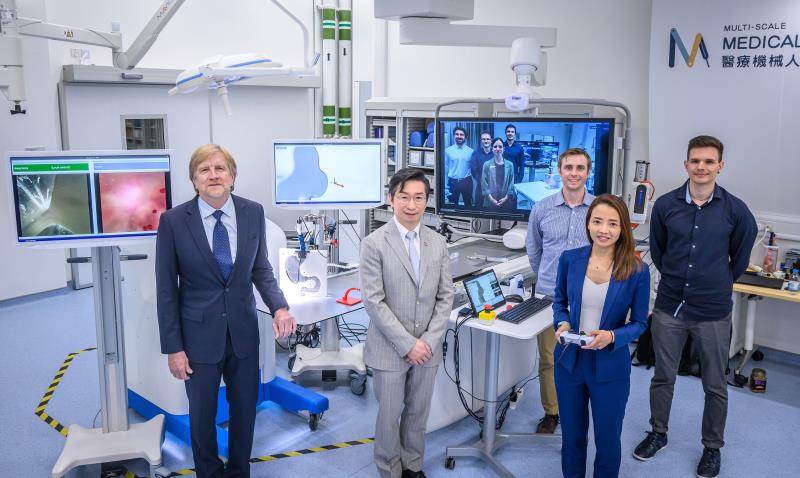World’s first teleoperated magnetic endoscopy performed in an animal model




 Prof Bradley Nelson (1st from left) and his team (right), Prof Philip Chiu (2nd from left), Dr Shannon Chan (2nd from right)
Prof Bradley Nelson (1st from left) and his team (right), Prof Philip Chiu (2nd from left), Dr Shannon Chan (2nd from right)Surgeons at the Chinese University of Hong Kong (CUHK) and the Swiss Federal Institute of Technology Zurich (ETH Zurich) have become the first in the world to perform teleoperated magnetic endoscopy in a porcine model across a distance of 9,300 km.
“Teleoperated robotic surgery is a rapidly growing field that promises to overcome geographical barriers and allow sharing of expertise over long distances for minimally invasive procedures,” wrote the researchers. A particularly promising technology is robotic magnetic navigation specifically developed for remote minimally invasive surgeries. [Adv Intell Syst 2024;2400522]
To demonstrate the teleoperative capabilities of robotic magnetic navigation, in vivo gastroscopy was performed in a porcine model, during which an operator in Zurich, Switzerland, successfully controlled a magnetic endoscope inside the porcine model in Hong Kong (9,300 km from Zurich). During the teleoperated procedure, stomach wall tissue was obtained for biopsy.
Notably, the teleoperated magnetic endoscope achieved full retroflexion (U-turn) within the stomach model, allowing visualization of the fundas at the entrance of the stomach. “Large bending angles can be challenging for magnetic endoscopes. Successful retroflexion is considered an important milestone as it proves that the magnetic endoscope can move as freely as standard devices,” remarked the researchers.
“The robotic magnetic navigation system generates external magnetic fields to safely and dexterously steer soft magnetic devices within the human body,” they added. “It allows the devices to be much smaller and more flexible, decreasing the risk of trauma, and improving dexterity, reachability, and precision.”
Communication between the operator console and the robotic system was established through a WebSocket via both institutions’ standard internet connections with a latency below 300 ms. This is a marked improvement compared with the first long-distance telesurgery, the Lindbergh Operation in 2001, which used an optical fibre connection between Strasbourg and New York (approximately 397 km apart) with a latency of 155 ms. Moving forward, the researchers will be performing teleoperated endoscopy on a human stomach. [Adv Intell Syst 2024;2400522; Ann Surg 2002;235:487]
“Teleoperated endoscopy offers not only remote surgical training and mentoring, but also immediate diagnostic and surgical care in remote areas, particularly when local expertise is lacking,” highlighted Dr Shannon Chan of the Department of Surgery, CUHK. “The procedures can even be performed by trained nurses under the supervision of a remote expert. Millions of patients worldwide will be able to receive diagnosis and treatment for gastrointestinal cancer promptly as endoscopic technology becomes more accessible.”
Beyond its use for GI procedures, a teleoperated magnetic navigation platform can be highly versatile and be employed in a broad range of remote minimally invasive procedures. “This includes neurovascular interventions, cardiac ablation, and foetal surgery,” pointed out Professor Bradley Nelson, Director of the Multi-Scale Robotics Lab, ETH Zurich.
“Teleoperated procedures could greatly enhance access to healthcare by creating a network of robotic platforms, which would facilitate global dissemination of surgical expertise,” commented Professor Philip Chiu, Dean of Medicine, CUHK.